Uncovering Innovativeness in Spanish Tourism Firms: The Role of Transformational Leadership, OCB, Firm Size, and Age
Abstract
1. Introduction
- Does TL affect firm innovativeness? How?
- Does OCB mediate the relationship between TL and firm innovativeness?
- Do firm size and age moderate the relationship between TL and firm innovativeness?
- Do firm size and age moderate the relationship between TL and OCB?
2. Literature Review
2.1. Transformational Leadership (TL), Organization Citizenship Behavior (OCB), and Firm Innovativeness (OI)
2.2. Organization Citizenship Behavior (OCB) and Firm Innovativeness (OI)
2.3. The Moderating Role of Firm Size and Age
3. Methodology
3.1. Industry Setting
3.2. Sample
3.3. Measurements
3.3.1. Transformational Leadership (TL)
3.3.2. Organization Citizenship Behavior (OCB)
3.3.3. Firm Innovativeness (OI)
3.3.4. Firm Size
3.3.5. Firm Age
3.3.6. Estimation Procedure
4. Results
4.1. Exploratory Factor Analysis (EFA)
4.2. Confirmatory Factor Analysis (CFA)
4.3. Hypotheses Testing and Regression Results
4.4. Mediation Analysis
4.5. Moderation Analysis
5. Discussion and Conclusions
5.1. Theoretical Implications
5.2. Managerial Implications
5.3. Firm Size and Age Implications
5.4. Limitations and Future Research
Author Contributions
Funding
Conflicts of Interest
References
- Sundbo, J.; Orfila-Sintes, F.; Sørensen, F. The innovative behaviour of tourism firms—Comparative studies of Denmark and Spain. Res. Policy 2007, 36, 88–106. [Google Scholar] [CrossRef]
- Hjalager, A.-M. Repairing innovation defectiveness in tourism. Tour. Manag. 2002, 23, 465–474. [Google Scholar] [CrossRef]
- Hjalager, A.-M. A review of innovation research in tourism. Tour. Manag. 2010, 31, 1–12. [Google Scholar] [CrossRef]
- Alsos, G.A.; Eide, D.; Madsen, E.L. Introduction: Innovation in Tourism Industries Handbook of Research on Innovation in Tourism Industries; Edward Elgar Publishing: Cheltenham, UK, 2014. [Google Scholar]
- Ritzer, G. The “McDonaldization” of society. J. Am. Cult. 1983, 6, 100–107. [Google Scholar] [CrossRef]
- Hall, M.C.; Williams, A. Tourism and Innovation; Routledge: London, UK, 2008. [Google Scholar]
- Sørensen, B.; Stuart, E.T. Aging, obsolescence, and organizational innovation. Adm. Sci. Q. 2000, 45, 81–112. [Google Scholar] [CrossRef]
- Clydesdale, G. Ski development and strategy. Tour. Hosp. Plan. Dev. 2007, 4, 1–23. [Google Scholar] [CrossRef]
- Orfila-Sintes, F.; Mattsson, J. Innovation behavior in the hotel industry. Omega 2009, 37, 380–394. [Google Scholar] [CrossRef]
- Guttentag, D.A.; Smith, S.L. Assessing Airbnb as a disruptive innovation relative to hotels: Substitution and comparative performance expectations. Int. J. Hosp. Manag. 2017, 64, 1–10. [Google Scholar] [CrossRef]
- Thomas, R.; Wood, E. Innovation in tourism: Re-conceptualising and measuring the absorptive capacity of the hotel sector. Tour. Manag. 2014, 45, 39–48. [Google Scholar] [CrossRef]
- Kent, T.W.; Crotts, J.C.; Azziz, A. Four factors of transformational leadership behavior. Leadersh. Organ. Dev. J. 2001, 22, 221–229. [Google Scholar] [CrossRef]
- Walumbwa, F.O.; Lawler, J.J. Building effective organizations: Transformational leadership, collectivist orientation, work-related attitudes and withdrawal behaviours in three emerging economies. Int. J. Hum. Resour. Manag. 2003, 14, 1083–1101. [Google Scholar] [CrossRef]
- Bass, B.M. Leadership and Performance beyond Expectations; Collier Macmillan: New York, NY, USA, 1985. [Google Scholar]
- Hongdao, Q.; Bibi, S.; Khan, A.; Ardito, L.; Nurunnabi, M. Does what goes around really comes around? The mediating effect of CSR on the relationship between transformational leadership and employee’s job performance in law firms. Sustainability 2019, 11, 3366. [Google Scholar] [CrossRef]
- Avolio, B.J.; Yammarino, F.J. Operationalizing charismatic leadership using a levels-of-analysis framework. Leadersh. Q. 1990, 1, 193–208. [Google Scholar] [CrossRef]
- Gumusluoglu, L.; Ilsev, A. Transformational leadership, creativity, and organizational innovation. J. Bus. Res. 2009, 62, 461–473. [Google Scholar] [CrossRef]
- Howell, J.M.; Avolio, B.J. Transformational leadership, transactional leadership, locus of control, and support for innovation: Key predictors of consolidated-business-unit performance. J. Appl. Psychol. 1993, 78, 891. [Google Scholar] [CrossRef]
- Bass, B.M. Does the transactional–transformational leadership paradigm transcend organizational and national boundaries? Am. Psychol. 1997, 52, 130. [Google Scholar] [CrossRef]
- Bass, B.M.; Avolio, B.J. The implications of transactional and transformational leadership for individual, team, and organizational development. Res. Organ. Chang. Dev. 1990, 4, 231–272. [Google Scholar]
- Bass, B.M.; Riggio, R.E. Transformational Leadership; Psychology Press: London, UK, 2006. [Google Scholar]
- Organ, D.W. Organizational Citizenship Behavior: The Good Soldier Syndrome; Lexington Books/DC Heath and Com: Washington, DC, USA, 1988. [Google Scholar]
- Podsakoff, P.M.; MacKenzie, S.B. Impact of organizational citizenship behavior on organizational performance: A review and suggestion for future research. Hum. Perform. 1997, 10, 133–151. [Google Scholar] [CrossRef]
- Bolino, M.C. Citizenship and impression management: Good soldiers or good actors? Acad. Manag. Rev. 1999, 24, 82–98. [Google Scholar] [CrossRef]
- Bergeron, D.M. The potential paradox of organizational citizenship behavior: Good citizens at what cost? Acad. Manag. Rev. 2007, 32, 1078–1095. [Google Scholar] [CrossRef]
- Morrison, E.W. Organizational citizenship behavior as a critical link between HRM practices and service quality. Hum. Resour. Manag. 1996, 35, 493–512. [Google Scholar] [CrossRef]
- Wei, Y.-C.; Han, T.-S.; Hsu, I.-C. High-performance HR practices and OCB: A cross-level investigation of a causal path. Int. J. Hum. Resour. Manag. 2010, 21, 1631–1648. [Google Scholar] [CrossRef]
- Johnson, J.W. The relative importance of task and contextual performance dimensions to supervisor judgments of overall performance. J. Appl. Psychol. 2001, 86, 984. [Google Scholar] [CrossRef] [PubMed]
- Werner, J.M. Dimensions that make a difference: Examining the impact of in-role and extrarole behaviors on supervisory ratings. J. Appl. Psychol. 1994, 79, 98. [Google Scholar] [CrossRef]
- Rotundo, M.; Sackett, P.R. The relative importance of task, citizenship, and counterproductive performance to global ratings of job performance: A policy-capturing approach. J. Appl. Psychol. 2002, 87, 66. [Google Scholar] [CrossRef]
- Van Scotter, J.; Motowidlo, S.J.; Cross, T.C. Effects of task performance and contextual performance on systemic rewards. J. Appl. Psychol. 2000, 85, 526. [Google Scholar] [CrossRef]
- Seibert, S.E.; Kraimer, M.L.; Liden, R.C. A social capital theory of career success. Acad. Manag. J. 2001, 44, 219–237. [Google Scholar]
- Amankwaa, A.; Gyensare, M.A.; Susomrith, P. Transformational leadership with innovative behaviour. Leadersh. Organ. Dev. J. Ghana 2019, 4, 402–420. [Google Scholar] [CrossRef]
- Rafferty, A.E.; Griffin, M.A. Dimensions of transformational leadership: Conceptual and empirical extensions. Leadersh. Q. 2004, 15, 329–354. [Google Scholar] [CrossRef]
- Ellemers, N.; De Gilder, D.; Haslam, S.A. Motivating individuals and groups at work: A social identity perspective on leadership and group performance. Acad. Manag. Rev. 2004, 29, 459–478. [Google Scholar] [CrossRef]
- Jaskyte, K. Transformational leadership, organizational culture, and innovativeness in nonprofit organizations. Nonprofit Manag. Leadersh. 2004, 15, 153–168. [Google Scholar] [CrossRef]
- Burns, J.M. NY: Harper and Row Publishers; Leadership: New York, NY, USA, 1978. [Google Scholar]
- Lee, J.-E.; Almanza, B.A.; Jang, S.S.; Nelson, D.C.; Ghiselli, R.F. Does transformational leadership style influence employees’ attitudes toward food safety practices? Int. J. Hosp. Manag. 2013, 33, 282–293. [Google Scholar] [CrossRef]
- Bass, B.M. Two decades of research and development in transformational leadership. Eur. J. Work Organ. Psychol. 1999, 8, 9–32. [Google Scholar] [CrossRef]
- Bottomley, P.; Mostafa, A.M.S.; Gould-Williams, J.S.; León-Cázares, F. The impact of transformational leadership on organizational citizenship behaviours: The contingent role of public service motivation. Br. J. Manag. 2016, 27, 390–405. [Google Scholar] [CrossRef]
- Piccolo, R.F.; Colquitt, J.A. Transformational leadership and job behaviors: The mediating role of core job characteristics. Acad. Manag. J. 2006, 49, 327–340. [Google Scholar] [CrossRef]
- Li, H.; Sajjad, N.; Wang, Q.; Muhammad Ali, A.; Khaqan, Z.; Amina, S. Influence of transformational leadership on employees’ innovative work behavior in sustainable organizations: Test of mediation and moderation processes. Sustainability 2019, 11, 1594. [Google Scholar] [CrossRef]
- Northouse, P.G. Leadership: Theory and Practice; Sage Publications: Thousand Oaks, CA, USA; Western Michigan University: Kalamazoo, MI, USA, 2018. [Google Scholar]
- Herrmann, D.; Felfe, J. Effects of leadership style, creativity technique and personal initiative on employee creativity. Br. J. Manag. 2014, 25, 209–227. [Google Scholar] [CrossRef]
- Kwak, W.J.; Kim, H.-K. Servant leadership and customer service quality at Korean hotels: Multilevel organizational citizenship behavior as a mediator. Soc. Behav. Personal. Int. J. 2015, 43, 1287–1298. [Google Scholar] [CrossRef]
- Hui, C.; Lam, S.S.; Schaubroeck, J. Can good citizens lead the way in providing quality service? A field quasi experiment. Acad. Manag. J. 2001, 44, 988–995. [Google Scholar]
- Podsakoff, P.M.; MacKenzie, S.B.; Paine, J.B.; Bachrach, D.G. Organizational citizenship behaviors: A critical review of the theoretical and empirical literature and suggestions for future research. J. Manag. 2000, 26, 513–563. [Google Scholar] [CrossRef]
- Bettencourt, L.A. Change-Oriented organizational citizenship behaviors: The direct and moderating influence of goal orientation. J. Retail. 2004, 80, 165–180. [Google Scholar] [CrossRef]
- López-Domínguez, M.; Enache, M.; Sallan, J.M.; Simo, P. Transformational leadership as an antecedent of change-oriented organizational citizenship behavior. J. Bus. Res. 2013, 66, 2147–2152. [Google Scholar] [CrossRef]
- Choi, J.N. Change-oriented organizational citizenship behavior: Effects of work environment characteristics and intervening psychological processes. J. Organ. Behav. Int. J. Ind. Occup. Organ. Psychol. Behav. 2007, 28, 467–484. [Google Scholar] [CrossRef]
- Kwan, H.K.; Liu, J.; Yim, F.H.-k. Effects of mentoring functions on receivers’ organizational citizenship behavior in a Chinese context: A two-study investigation. J. Bus. Res. 2011, 64, 363–370. [Google Scholar] [CrossRef]
- Avolio, B.J.; Bass, B.M.; Jung, D.I. Re-Examining the components of transformational and transactional leadership using the Multifactor Leadership. J. Occup. Organ. Psychol. 1999, 7272, 441–462. [Google Scholar] [CrossRef]
- Jiao, C.; Richards, D.A.; Zhang, K. Leadership and organizational citizenship behavior: OCB-specific meanings as mediators. J. Bus. Psychol. 2011, 26, 11–25. [Google Scholar] [CrossRef]
- Humphrey, A. Transformational leadership and organizational citizenship behaviors: The role of organizational identification. Psychol. Manag. J. 2012, 15, 247–268. [Google Scholar] [CrossRef]
- Lowe, K.B.; Galen Kroeck, K.; Sivasubramaniam, N. Effectiveness correlates of transformational and transactional leadership: A meta-analytic. Leadersh. Q. 1996, 7, 385. [Google Scholar] [CrossRef]
- Avolio, B.J.; Zhu, W.; Koh, W.; Bhatia, P. Transformational leadership and organizational commitment: Mediating role of psychological empowerment and moderating role of structural distance. J. Organ. Behav. Int. J. Ind. Occup. Organ. Psychol. Behav. 2004, 25, 951–968. [Google Scholar] [CrossRef]
- Podsakoff, P.M.; MacKenzie, S.B.; Moorman, R.H.; Fetter, R. Transformational leader behaviors and their effects on followers’ trust in leader, satisfaction, and organizational citizenship behaviors. Leadersh. Q. 1990, 1, 107–142. [Google Scholar] [CrossRef]
- Lall, S.; Dunning, J.; Hamdani, K. The New Globalism and Developing Countries; UNU Press: Tokyo, Japan, 1997. [Google Scholar]
- Wahab, S.; Cooper, C. Tourism, Globalisation and the Competitive Advantage of Nations Tourism in the Age of Globalisation; Routledge: London, UK, 2005; pp. 17–35. [Google Scholar]
- Vaccaro, I.G.; Jansen, J.J.; Van Den Bosch, F.A.; Volberda, H.W. Management innovation and leadership: The moderating role of organizational size. J. Manag. Stud. 2012, 49, 28–51. [Google Scholar] [CrossRef]
- Ford, C.M. The futurity of decisions as a facilitator of organizational creativity and change. J. Organ. Chang. Manag. 2002, 15, 635–646. [Google Scholar] [CrossRef]
- Elkins, T.; Keller, R.T. Leadership in research and development organizations: A literature review and conceptual framework. Leadersh. Q. 2003, 14, 587–606. [Google Scholar] [CrossRef]
- Organ, D.W.; Podsakoff, P.M.; MacKenzie, S.B. Organizational Citizenship Behavior: Its Nature, Antecedents, and Consequences; Sage Publications: Thousand Oaks, CA, USA, 2005. [Google Scholar]
- Miao, R.-T.; Kim, H.-G. Gender as a moderator of the relationship between organizational citizenship behaviors and team effectiveness in China. Asian Soc. Sci. 2009, 5, 98. [Google Scholar] [CrossRef][Green Version]
- Walz, S.M.; Niehoff, B.P. Organizational citizenship behaviors: Their relationship to organizational effectiveness. J. Hosp. Tour. Res. 2000, 24, 301–319. [Google Scholar] [CrossRef]
- Pan, F.C. Practical application of importance-performance analysis in determining critical job satisfaction factors of a tourist hotel. Tour. Manag. 2015, 46, 84–91. [Google Scholar] [CrossRef]
- Hurley, R.F.; Hult, G.T.M.; Knight, G.A. Innovativeness and capacity to innovate in a complexity of firm-level relationships: A response to Woodside 2004. Ind. Mark. Manag. 2005, 34, 281–283. [Google Scholar] [CrossRef]
- Salavou, H. The concept of innovativeness: Should we need to focus? Eur. J. Innov. Manag. 2004. [Google Scholar] [CrossRef]
- Lumpkin, G.T.; Dess, G.G. Clarifying the entrepreneurial orientation construct and linking it to performance. Acad. Manag. Rev. 1996, 21, 135–172. [Google Scholar] [CrossRef]
- Baer, M.; Frese, M. Innovation is not enough: Climates for initiative and psychological safety, process innovations, and firm performance. J. Organ. Behav. Int. J. Ind. Occup. Organ. Psychol. Behav. 2003, 24, 45–68. [Google Scholar] [CrossRef]
- Wang, C.L.; Ahmed, P.K. The development and validation of the organisational innovativeness construct using confirmatory factor analysis. Eur. J. Innov. Manag. 2004, 7, 303–313. [Google Scholar] [CrossRef]
- Ruvio, A.A.; Shoham, A.; Vigoda-Gadot, E.; Schwabsky, N. Organizational innovativeness: Construct development and cross-cultural validation. J. Prod. Innov. Manag. 2014, 31, 1004–1022. [Google Scholar] [CrossRef]
- Chattalas, M.; Koles, B.; Wojtczuk-Turek, A.; Turek, D. The significance of perceived social-organization climate for creating employees’ innovativeness. Manag. Res. Rev. 2016, 39, 167–195. [Google Scholar]
- Zhang, Z.; Wan, D.; Jia, M. Do high-performance human resource practices help corporate entrepreneurship? The mediating role of organizational citizenship behavior. J. High Technol. Manag. Res. 2008, 19, 128–138. [Google Scholar] [CrossRef]
- Yan, L.; Yan, J. Leadership, organizational citizenship behavior, and innovation in small business: An empirical study. J. Small Bus. Entrep. 2013, 26, 183–199. [Google Scholar] [CrossRef]
- Podsakoff, N.P.; Whiting, S.W.; Podsakoff, P.M.; Blume, B.D. Individual-and organizational-level consequences of organizational citizenship behaviors: A meta-analysis. J. Appl. Psychol. 2009, 94, 122. [Google Scholar] [CrossRef]
- Carmeli, A.; Spreitzer, G.M. Trust, connectivity, and thriving: Implications for innovative behaviors at work. J. Creat. Behav. 2009, 43, 169–191. [Google Scholar] [CrossRef]
- Xerri, M.J.; Brunetto, Y. Fostering innovative behaviour: The importance of employee commitment and organisational citizenship behaviour. Int. J. Hum. Resour. Manag. 2013, 24, 3163–3177. [Google Scholar] [CrossRef]
- Turnipseed, P.H.; Turnipseed, D.L. Testing the proposed linkage between organizational citizenship behaviours and an innovative organizational climate. Creat. Innov. Manag. 2013, 22, 209–216. [Google Scholar] [CrossRef]
- Yi, T. Team psychological safety, organizational citizenship behavior and team innovation: A mediation analysis. Nankai Bus. Rev. 2005, 6, 210–221. [Google Scholar]
- Naqshbandi, D.M.; Kaur, S. A study of organizational citizenship behaviours, organizational structures and open innovation. Organ. Struct. Open Innov. 2013. [Google Scholar] [CrossRef]
- Organ, D.W. Organizational citizenship behavior: It’s construct clean-up time. Hum. Perform. 1997, 10, 85–97. [Google Scholar] [CrossRef]
- Yu, X.; Song, C. The influence path analysis of OCB on innovation performance: Based on the intermediary role of knowledge management. In Proceedings of the 2014 International Conference on Management Science & Engineering 21th Annual Conference Proceeding, Helsinki, Finland, 17–19 August 2014. [Google Scholar]
- Deb Chowdhury, D. Deviant Citizenship Behavior: A comprehensive framework towards behavioral excellence in organizations. East. Asian J. Bus. Manag. 2015, 5, 13–26. [Google Scholar] [CrossRef]
- Waldman, D.A.; Bass, B.M. Transformational leadership at different phases of the innovation process. J. High Technol. Manag. Res. 1991, 2, 169–180. [Google Scholar] [CrossRef]
- Hunt, J.G.J.; Stelluto, G.E.; Hooijberg, R. Toward new-wave organization creativity: Beyond romance and analogy in the relationship between orchestra-conductor leadership and musician creativity. Leadersh. Q. 2004, 15, 145–162. [Google Scholar] [CrossRef]
- Lavelle, J.J.; Brockner, J.; Konovsky, M.A.; Price, K.H.; Henley, A.B.; Taneja, A.; Vinekar, V. Commitment, procedural fairness, and organizational citizenship behavior: A multifoci analysis. J. Organ. Behav. Int. J. Ind. Occup. Organ. Psychol. Behav. 2009, 30, 337–357. [Google Scholar] [CrossRef]
- Kim, H. Transformational leadership, organizational clan culture, organizational affective commitment, and organizational citizenship behavior: A case of South Korea’s public sector. Public Organ. Rev. 2014, 14, 397–417. [Google Scholar] [CrossRef]
- Vigoda, E.; Golembiewski, R.T. Citizenship behavior and the spirit of new managerialism: A theoretical framework and challenge for governance. Am. Rev. Public Adm. 2001, 31, 273–295. [Google Scholar] [CrossRef]
- Jacob, M.; Groizard, J.L. Technology transfer and multinationals: The case of Balearic hotel chains’ investments in two developing economies. Tour. Manag. 2007, 28, 976–992. [Google Scholar] [CrossRef]
- Petruzzelli, A.M.; Ardito, L.; Savino, T. Maturity of knowledge inputs and innovation value: The moderating effect of firm age and size. J. Bus. Res. 2018, 86, 190–201. [Google Scholar] [CrossRef]
- Ling, Y.; Simsek, Z.; Lubatkin, M.H.; Veiga, J.F. The impact of transformational CEOs on the performance of small-to medium-sized firms: Does organizational context matter? J. Appl. Psychol. 2008, 93, 923. [Google Scholar] [CrossRef] [PubMed]
- Khan, R.; Rehman, A.U.; Fatima, A. Transformational leadership and organizational innovation: Moderated by organizational size. Afr. J. Bus. Manag. 2009, 3, 678. [Google Scholar]
- Jung, D.D.; Wu, A.; Chow, C.W. Towards understanding the direct and indirect effects of CEOs’ transformational leadership on firm innovation. Leadersh. Q. 2008, 19, 582–594. [Google Scholar] [CrossRef]
- Hipp, C.; Tether, B.S.; Miles, I. The incidence and effects of innovation in services: Evidence from Germany. Int. J. Innov. Manag. 2000, 4, 417–453. [Google Scholar] [CrossRef]
- Jacob, M.; Tintoré, J.; Aguiló, E.; Bravo, A.; Mulet, J. Innovation in the tourism sector: Results from a pilot study in the Balearic Islands. Tour. Econ. 2003, 9, 279–295. [Google Scholar] [CrossRef]
- Cha, J.; Kim, Y.; Lee, J.-Y.; Bachrach, D.G. Transformational leadership and inter-team collaboration: Exploring the mediating role of teamwork quality and moderating role of team size. Group Organ. Manag. 2015, 40, 715–743. [Google Scholar] [CrossRef]
- Tarus, D.K.; Sitienei, E.K. Intellectual capital and innovativeness in software development firms: The moderating role of firm size. J. Afr. Bus. 2015, 16, 48–65. [Google Scholar] [CrossRef]
- Santoro, M.D.; Chakrabarti, A.K. Firm size and technology centrality in industry–university interactions. Res. Policy 2002, 31, 1163–1180. [Google Scholar] [CrossRef]
- Steele, J.; Murray, M. Creating, supporting and sustaining a culture of innovation. Eng. Constr. Archit. Manag. 2004. [Google Scholar] [CrossRef]
- Sirilli, G.; Evangelista, R. Technological innovation in services and manufacturing: Results from Italian surveys. Res. Policy 1998, 27, 881–899. [Google Scholar] [CrossRef]
- Forés, B.; Camisón, C. Does incremental and radical innovation performance depend on different types of knowledge accumulation capabilities and organizational size? J. Bus. Res. 2016, 69, 831–848. [Google Scholar] [CrossRef]
- Chung, W.; Kalnins, A. Agglomeration effects and performance: A test of the Texas lodging industry. Strateg. Manag. J. 2001, 22, 969–988. [Google Scholar] [CrossRef]
- Gopalakrishnan, S.; Bierly, P.E. The impact of firm size and age on knowledge strategies during product development: A study of the drug delivery industry. IEEE Trans. Eng. Manag. 2006, 53, 3–16. [Google Scholar] [CrossRef]
- Naldi, L.; Davidsson, P. Entrepreneurial growth: The role of international knowledge acquisition as moderated by firm age. J. Bus. Ventur. 2014, 29, 687–703. [Google Scholar] [CrossRef]
- Chiaroni, D.; Chiesa, V.; Frattini, F.; Turba, L. Exploring the relationship between incumbency and radical innovation: The case of business to consumer e-commerce applications. Int. J. Entrep. Innov. Manag. 2010, 11, 419–439. [Google Scholar] [CrossRef]
- Hill, C.W.; Rothaermel, F.T. The performance of incumbent firms in the face of radical technological innovation. Acad. Manag. Rev. 2003, 28, 257–274. [Google Scholar] [CrossRef]
- Raffaelli, R.; Glynn, M.A. Turnkey or tailored? Relational pluralism, institutional complexity, and the organizational adoption of more or less customized practices. Acad. Manag. J. 2014, 57, 541–562. [Google Scholar] [CrossRef]
- Kotha, R.; Zheng, Y.; George, G. Entry into new niches: The effects of firm age and the expansion of technological capabilities on innovative output and impact. Strateg. Manag. J. 2011, 32, 1011–1024. [Google Scholar] [CrossRef]
- Arora, A.; Gambardella, A.; Magazzini, L.; Pammolli, F. A breath of fresh air? Firm type, scale, scope, and selection effects in drug development. Manag. Sci. 2009, 5555, 1638–1653. [Google Scholar] [CrossRef]
- World Bank. World Bank Open Data. Available online: https://data.worldbank.org/indicator/ST.INT.ARVL?locations=ES (accessed on 6 January 2020).
- The Guardian. Spain Set to Replace US as Second Most Popular Tourism Destination. Available online: https://www.theguardian.com/world/2018/jan/16/spain-set-to-replace-us-as-second-most-popular-tourism-destination (accessed on 16 February 2018).
- Alidad, V. Tourism and Technology, Bienvenido to the Intelligent Traveler. WORLDCRUNCH. Available online: https://www.worldcrunch.com/food-travel/tourism-and-technology-bienvenido-to-the-intelligent-traveler (accessed on 3 February 2020).
- Statista. Number of travel agencies, tour operators and other reservation service enterprises in Spain from 2008 to 2019. Available online: https://www.statista.com/statistics/436259/number-of-travel-agencies-and-other-reservation-services-in-spain/ (accessed on 30 April 2020).
- Lee, K.; Allen, N.J. Organizational citizenship behavior and workplace deviance: The role of affect and cognitions. J. Appl. Psychol. 2002, 87, 131. [Google Scholar] [CrossRef]
- Williams, S.; Pitre, R.; Zainuba, M. Justice and organizational citizenship behavior intentions: Fair rewards versus fair treatment. J. Soc. Psychol. 2002, 142, 33–44. [Google Scholar] [CrossRef] [PubMed]
- Farid, T.; Iqbal, S.; Ma, J.; Castro-González, S.; Khattak, A.; Khan, M.K. Employees’ perceptions of CSR, work engagement, and organizational citizenship behavior: The mediating effects of organizational justice. Int. J. Environ. Res. Public Health 2019, 16, 1731. [Google Scholar] [CrossRef] [PubMed]
- Thomas Hurt, H.; Ward Teigen, C. The development of a measure of perceived organizational innovativeness. Ann. Int. Commun. Assoc. 1977, 1, 377–385. [Google Scholar] [CrossRef]
- Hsiao, H.-C.; Chang, J.-C. The role of organizational learning in transformational leadership and organizational innovation. Asia Pac. Educ. Rev. 2011, 12, 621. [Google Scholar] [CrossRef]
- Costello, A.B.; Osborne, J.W. Best practices in exploratory factor analysis: Four recommendations for getting the most from your analysis. Pract. Assess. Res. Eval. 2005, 10, 1–9. [Google Scholar]
- Brown, T.A. Confirmatory Factor Analysis for Applied Research; Guilford publications: New York, NY, USA, 2015. [Google Scholar]
- Podsakoff, P.M.; MacKenzie, S.B.; Lee, J.-Y.; Podsakoff, N.P. Common method biases in behavioral research: A critical review of the literature and recommended remedies. J. Appl. Psychol. 2003, 88, 879. [Google Scholar] [CrossRef]
- Taasoobshirazi, G.; Wang, S. The performance of the SRMR, RMSEA, CFI, and TLI: An examination of sample size, path size, and degrees of freedom. J. Appl. Quant. Methods 2016, 11, 31–40. [Google Scholar]
- Brosseau-Liard, P.E.; Savalei, V.; Li, L. An investigation of the sample performance of two nonnormality corrections for RMSEA. Multivar. Behav. Res. 2012, 47, 904–930. [Google Scholar] [CrossRef]
- Hayes, A.F. Introduction to Mediation, Moderation, and Conditional Process Analysis: A Regression-Based Approach; Guilford publications: New York, NY, USA, 2017. [Google Scholar]
- Vatcheva, K.P.; Lee, M.; McCormick, J.B.; Rahbar, M.H. Multicollinearity in regression analyses conducted in epidemiologic studies. Epidemiology 2016, 6, 2. [Google Scholar] [CrossRef] [PubMed]
- Hair, J.F.; Black, W.C.; Babin, B.J.; Anderson, R.E.; Tatham, R.L. Multivariate Data Analysis; Prentice Hall: Upper Saddle River, NJ, USA, 1998; Volume 5. [Google Scholar]
- Hardy, M.A.; Bryman, A. Handbook of Data Analysis; Sage: Thousand Oaks, CA, USA, 2009. [Google Scholar]
- García-Morales, V.J.; Jiménez-Barrionuevo, M.M.; Gutiérrez-Gutiérrez, L. Transformational leadership influence on organizational performance through organizational learning and innovation. J. Bus. Res. 2012, 65, 1040–1050. [Google Scholar] [CrossRef]
- Carmeli, A.; Sheaffer, Z.; Binyamin, G.; Reiter-Palmon, R.; Shimoni, T. Transformational leadership and creative problem-solving: The mediating role of psychological safety and reflexivity. J. Creat. Behav. 2014, 48, 115–135. [Google Scholar] [CrossRef]
- Raj, R.; Srivastava, K.B. Transformational leadership and innovativeness: The mediating role of organizational learning. J. Manag. Res. 2016, 16, 201–219. [Google Scholar]
- Lee, J. Effects of leadership and leader-member exchange on innovativeness. J. Manag. Psychol. 2008. [Google Scholar] [CrossRef]
- Bommer, W.H.; Miles, E.W.; Grover, S.L. Does one good turn deserve another? Coworker influences on employee citizenship. J. Organ. Behav. Int. J. Ind. Occup. Organ. Psychol. Behav. 2003, 24, 181–196. [Google Scholar] [CrossRef]
- Waldman, D.A.; Ramirez, G.G.; House, R.J.; Puranam, P. Does leadership matter? CEO leadership attributes and profitability under conditions of perceived environmental uncertainty. Acad. Manag. J. 2001, 44, 134–143. [Google Scholar]
- Martin, L.M. E-innovation: Internet impacts on small UK hospitality firms. Int. J. Contemp. Hosp. Manag. 2004, 16, 82–90. [Google Scholar] [CrossRef]
- Barnard, C.I. The Functions of the Executive (Cambridge) Mass. In Barnard the Functions of the Executive 1938; Harvard University Press: Cambridge, UK, 1938. [Google Scholar]
- Katz, D.; Kahn, R.L. The Social Psychology of Organizations; Wiley: New York, NY, USA, 1978; Volume 2. [Google Scholar]
- George, J.M.; Brief, A.P. Feeling good-doing good: A conceptual analysis of the mood at work-organizational spontaneity relationship. Psychol. Bull. 1992, 112, 310. [Google Scholar] [CrossRef]
- George, J.M.; Jones, G.R. Organizational spontaneity in context. Hum. Perform. 1997, 10, 153–170. [Google Scholar] [CrossRef]
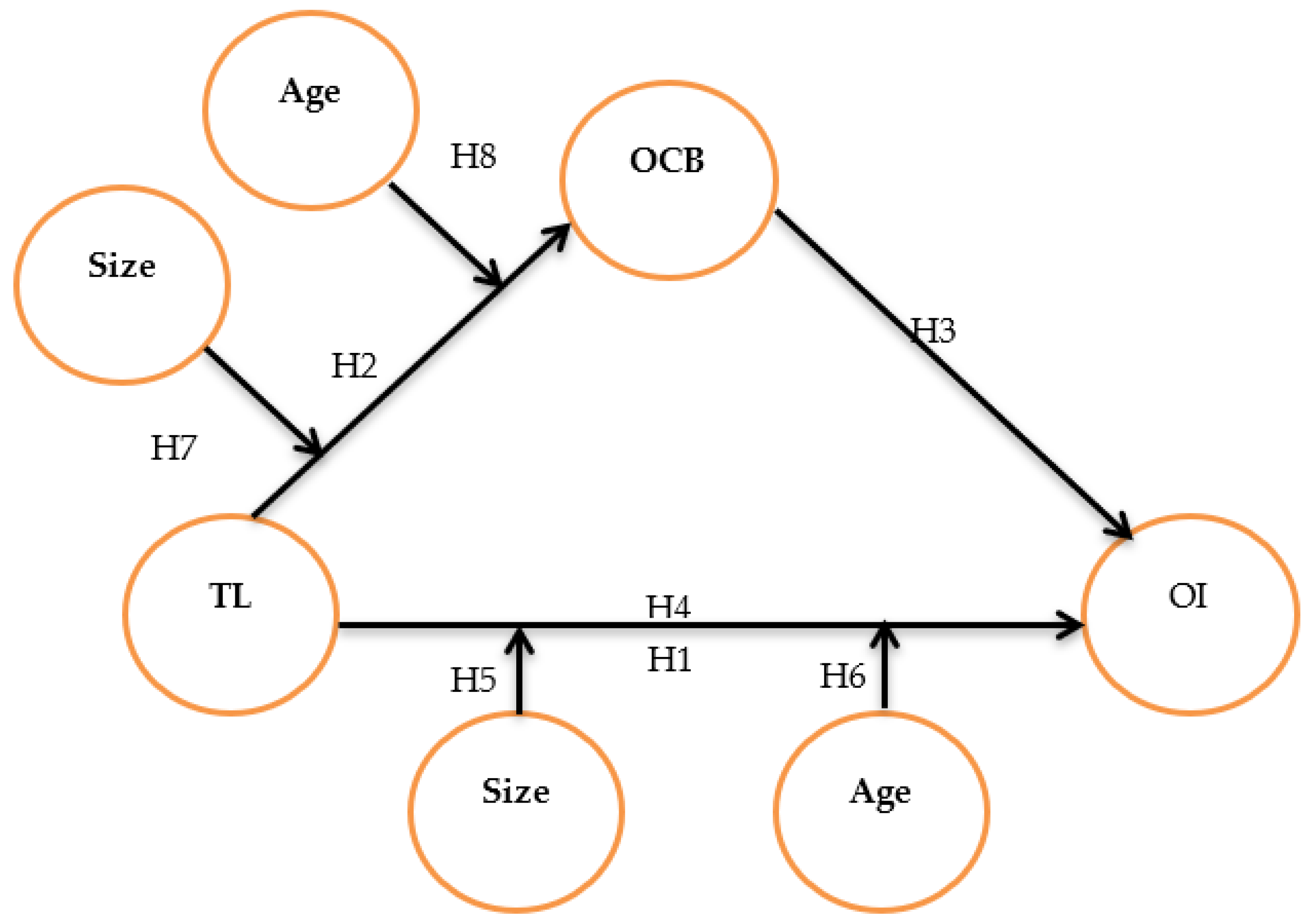
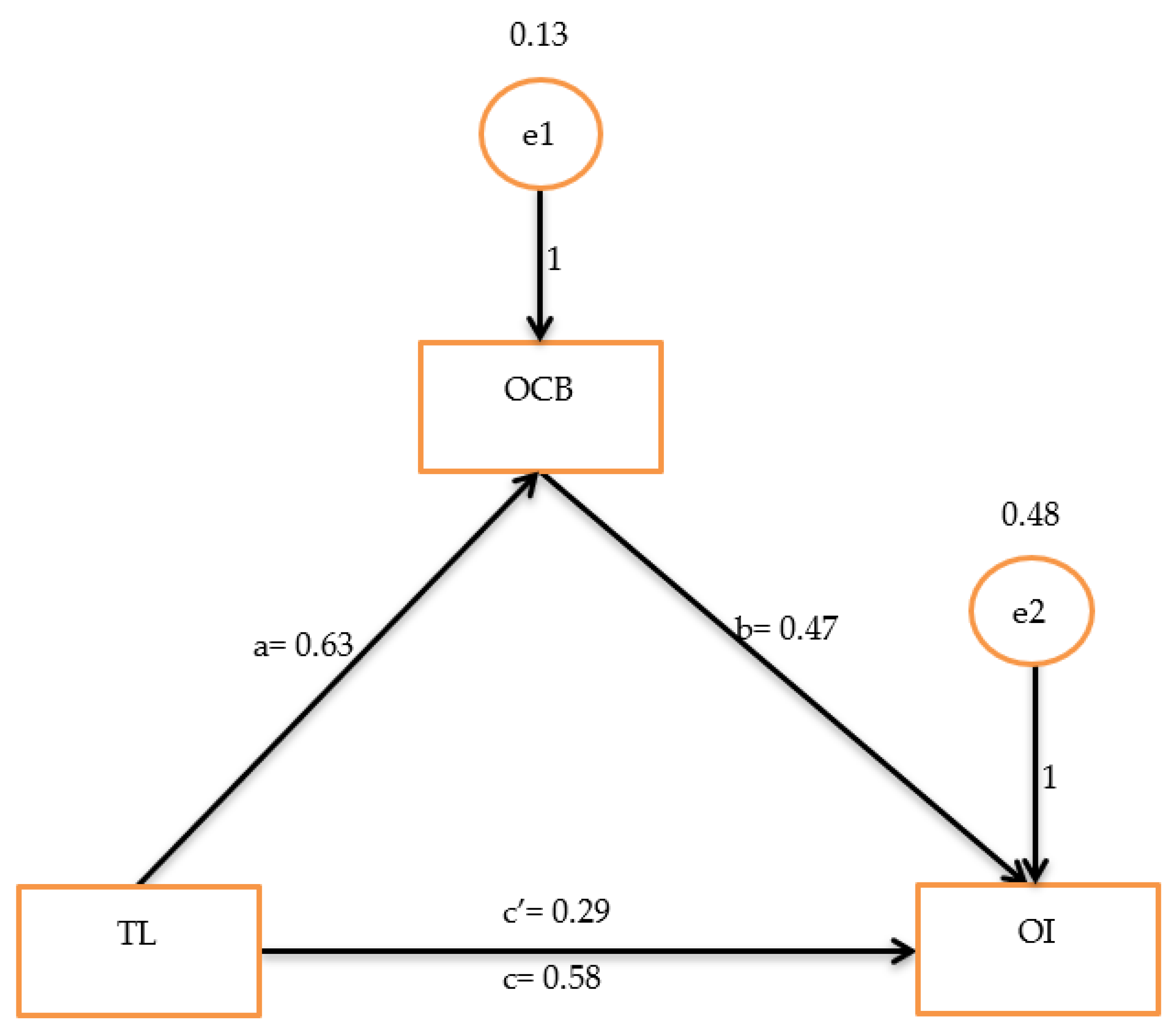
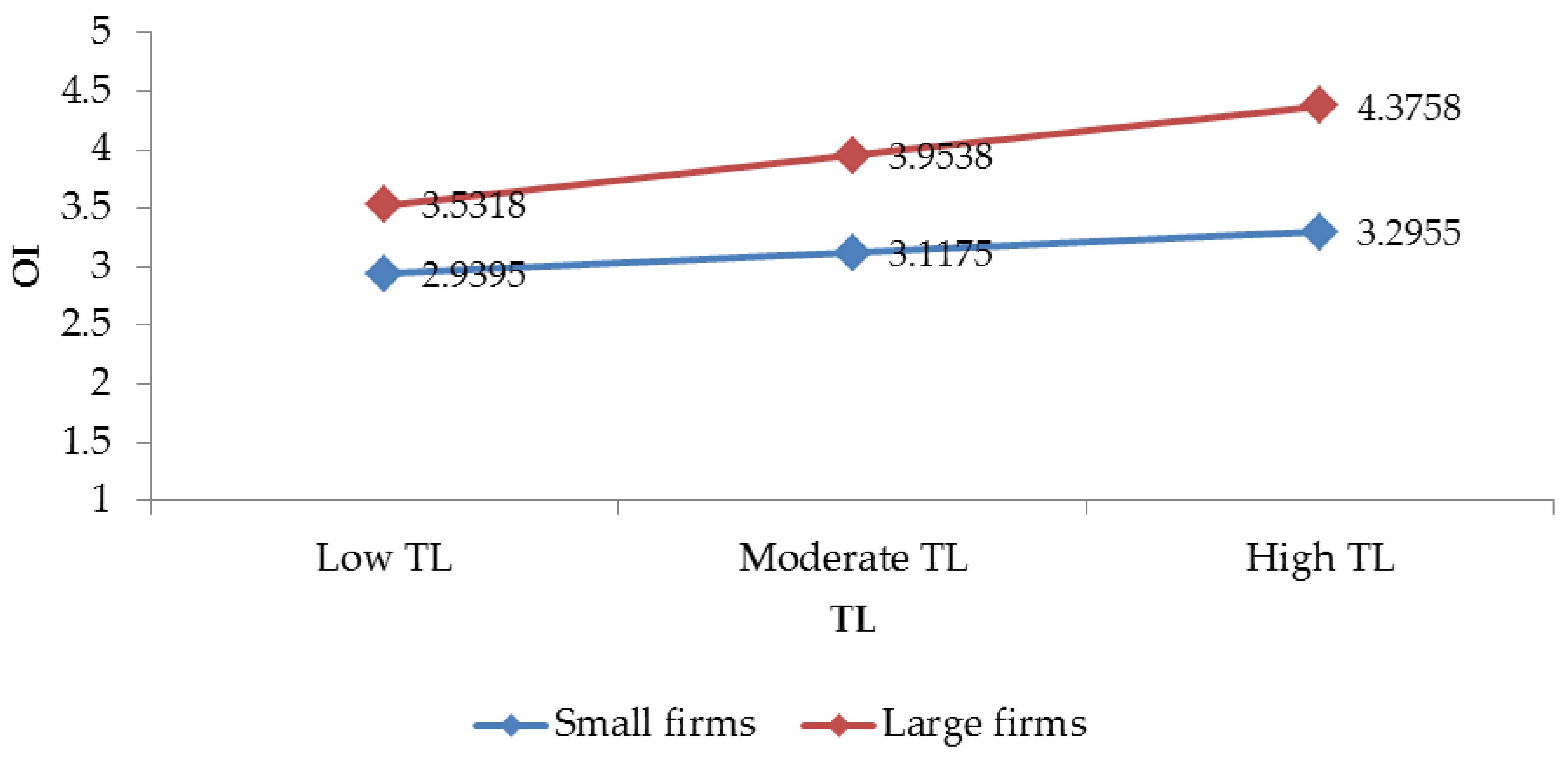
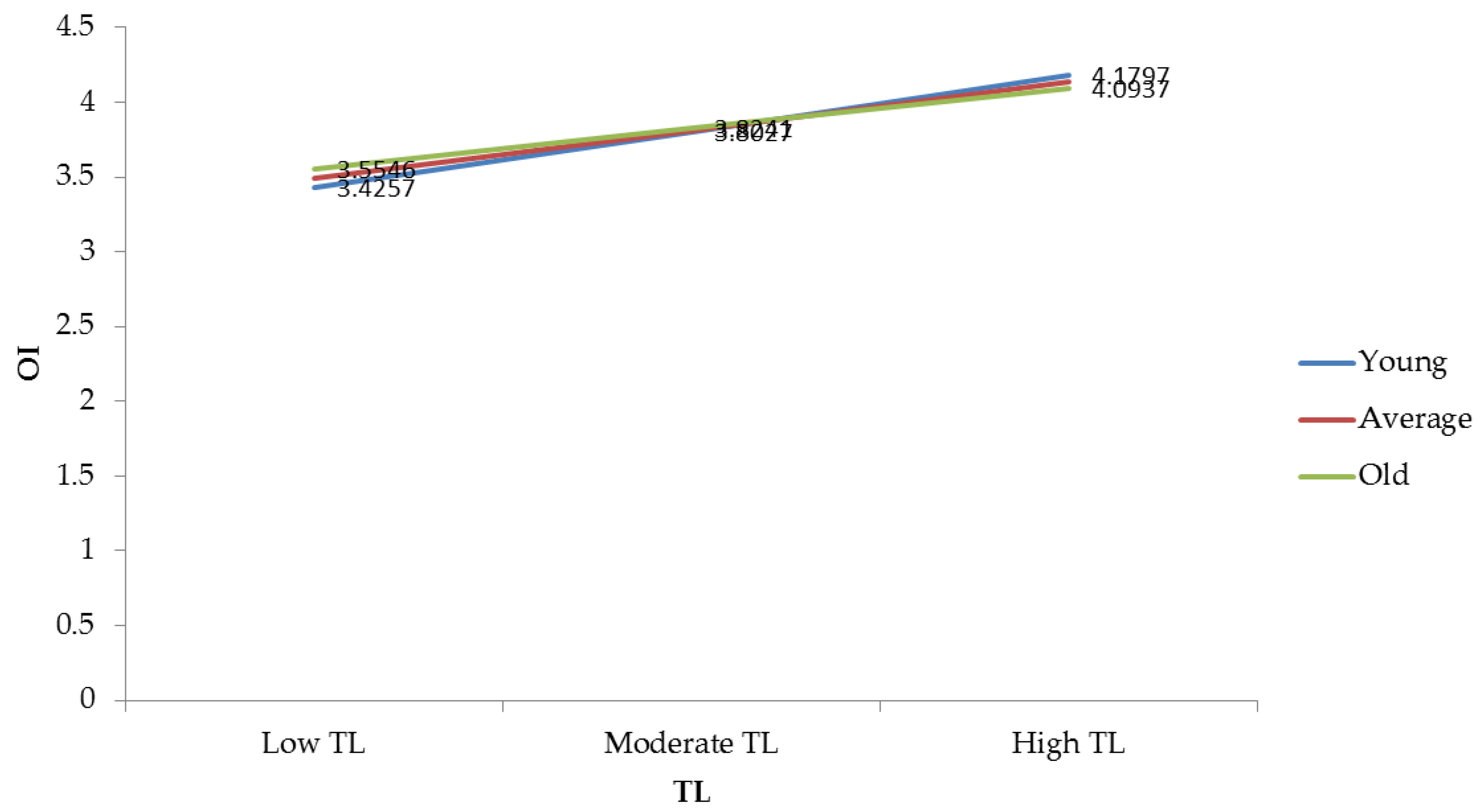
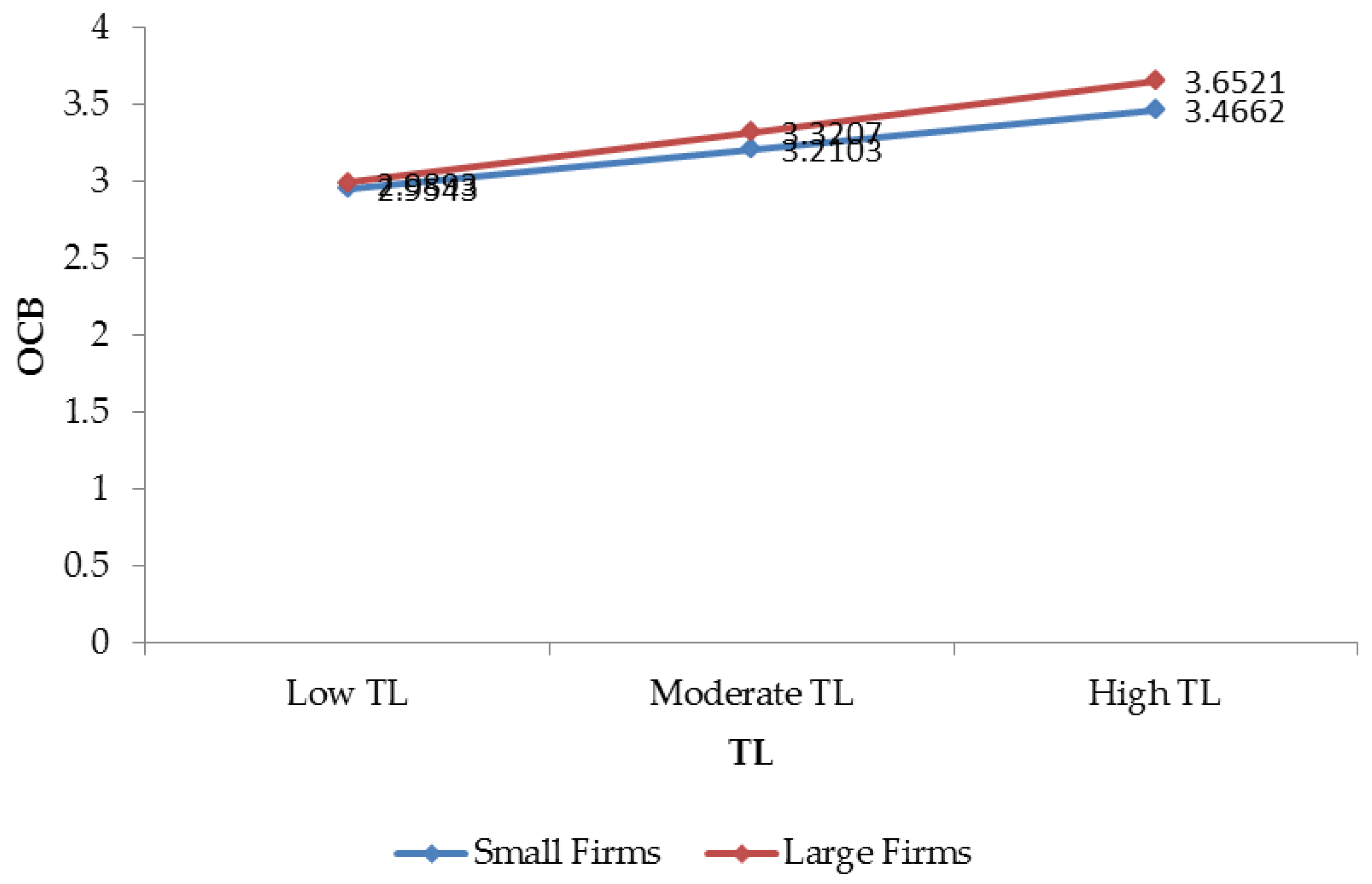
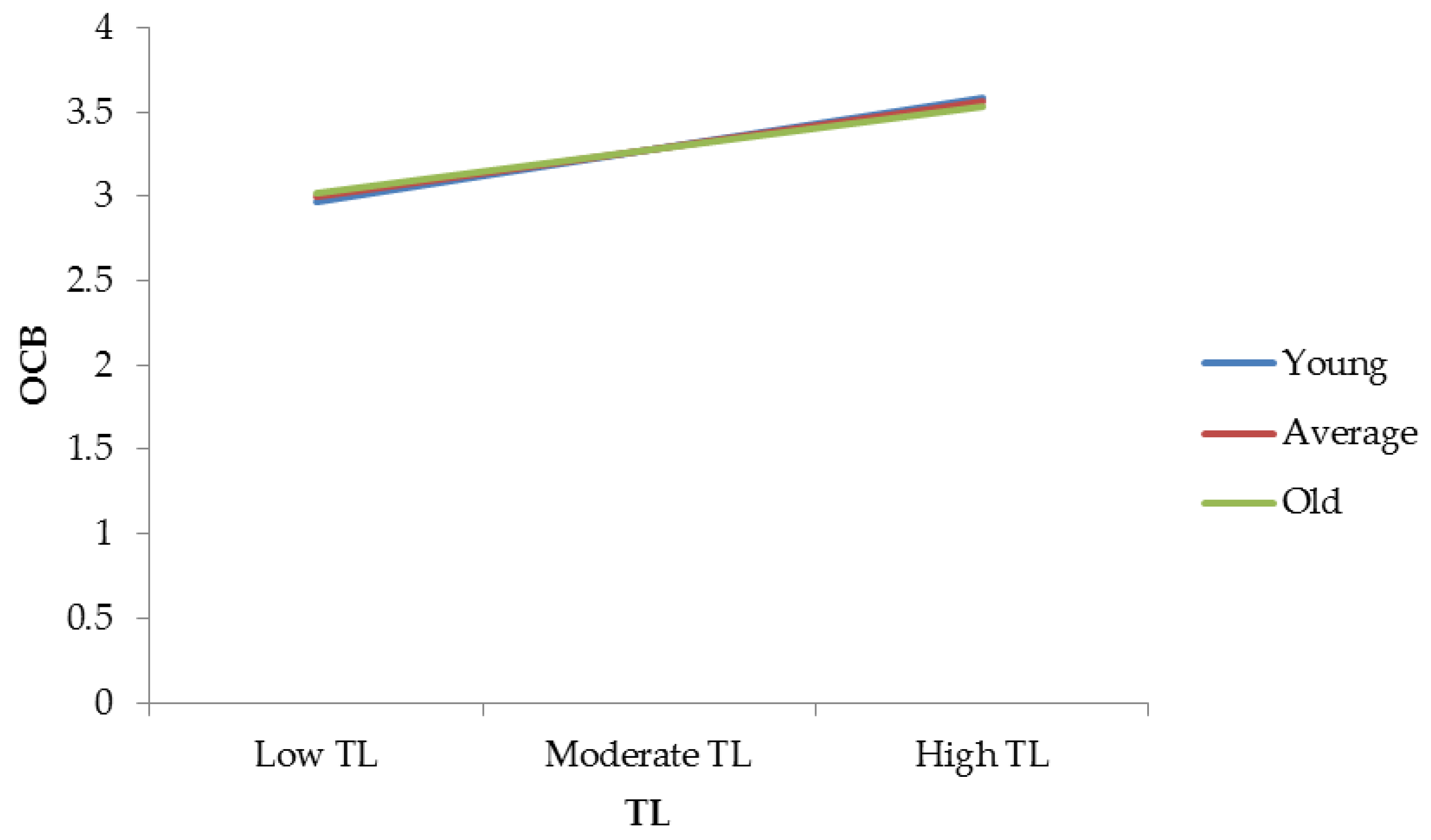
| Demographic | Frequency | Percentage |
|---|---|---|
| Gender | ||
| Male | 183 | 55.6% |
| Female | 146 | 44.4% |
| Education | ||
| Secondary | 21 | 6.4% |
| Bachelor | 56 | 17% |
| Master | 141 | 42% |
| PhD | 46 | 14% |
| Vocational training | 65 | 19.8% |
| Firm Type | ||
| Government firms | 114 | 34.7% |
| Semi government firms | 62 | 18.8% |
| Private firms | 153 | 46.5% |
| Firm Size | ||
| Small | 122 | 37.08% |
| Large | 207 | 62.92% |
| Firm Age | ||
| Young | 110 | 33.43% |
| Average | 116 | 35.26% |
| Old | 103 | 31.31% |
| Items | Factor Loadings | Individual KMO | Variance Explained | Reliability | ||
|---|---|---|---|---|---|---|
| TL | OCB | OI | Cronbach’s Alpha | |||
| TL2 | 0.920 | 0.890 | 24.144 | 0.904 | ||
| TL4 | 0.920 | 0.815 | ||||
| TL6 | 0.884 | 0.788 | ||||
| TL8 | 0.794 | 0.825 | ||||
| OCB2 | 0.788 | 0.768 | 21.565 | 0.801 | ||
| OCB3 | 0.752 | 0.802 | ||||
| OCB5 | 0.745 | 0.810 | ||||
| OCB7 | 0.602 | 0.764 | ||||
| OCB8 | 0.609 | 0.795 | ||||
| OI1 | 0.754 | 0.832 | 14.628 | 0.763 | ||
| OI3 | 0.740 | 0.713 | ||||
| OI5 | 0.709 | 0.758 | ||||
| OI6 | 0.718 | 0.812 | ||||
| Model Fit Indices | Model 1 | Model 2 | Model 3 |
|---|---|---|---|
| CMIN/df | 1.050 | 8.374 | 10.398 |
| P-value for model | 0.370 | 0.000 | 0.000 |
| CFI | 0.998 | 0.691 | 0.600 |
| TLI | 0.997 | 0.624 | 0.520 |
| GFI | 0.970 | 0.637 | 0.699 |
| AGFI | 0.956 | 0.673 | 0.579 |
| SRMR | 0.016 | 0.070 | 0.080 |
| RMESA | 0.012 | 0.150 | 0.169 |
| PCLOSE | 0.999 | 0.000 | 0.000 |
| Construct | CR | AVE | MSV | ASV | MaxR(H) | TL | OCB | OI |
|---|---|---|---|---|---|---|---|---|
| TL | 0.908 | 0.715 | 0.0225 | 0.0121 | 0.927 | 0.845 | ||
| OCB | 0.789 | 0.529 | 0.0441 | 0.0333 | 0.806 | 0.627 | 0.727 | |
| OI | 0.821 | 0.534 | 0.0441 | 0.0229 | 0.586 | 0.543 | 0.601 | 0.730 |
| Variables | Mean | SD | 1 | 2 | 3 | 4 | 5 | 6 |
|---|---|---|---|---|---|---|---|---|
| TL | 3.618 | 0.438 | 1 | |||||
| OCB | 3.278 | 0.461 | 0.627 * | 1 | ||||
| OI | 3.813 | 0.591 | 0.543 * | 0.601 * | 1 | |||
| Age | 1.978 | 0.805 | 0.004 ** | −0.022 | 0.021 ** | 1 | ||
| Firm Type | 2.12 | 0.890 | 0.066 | 0.060 | 0.036 | −0.666 * | 1 | |
| Firm Size | 0.629 | 0.484 | 0.056 | 0.025 | 0.502 * | 0.720 | 0.120 | 1 |
| Bootstrapping | ||||||
|---|---|---|---|---|---|---|
| Paths | Coefficient | SE | t | Significance (p) | LLCI | ULCI |
| TL→OCB (a) | 0.6290 | 0.0452 | 13.925 | 0.0000 | 0.5401 | 0.7178 |
| OCB→OI (b) | 0.4725 | 0.1049 | 4.5060 | 0.0000 | 0.2662 | 0.6788 |
| TL→ OCB→ OI (c’) | 0.2915 | 0.0881 | 2.6969 | 0.0074 | 0.0789 | 0.5042 |
| TL→ OI (c) | 0.5887 | 0.0881 | 6.6793 | 0.0000 | 0.4153 | 0.7621 |
| Indirect effect | 0.2972 | 0.0736 | 0.1647 | 0.4544 | ||
| Moderation Model 1 (dependent OI) | ||||||
| Firm size | 0.8363 | 0.0660 | 12.677 | 0.0000 | 0.7065 | 0.9661 |
| Firm size x TL | 0.5458 | 0.1428 | 3.8232 | 0.0002 | 0.2649 | 0.8266 |
| Conditional Effects | ||||||
| Small firm size (0) | 0.3981 | 0.1002 | 3.9737 | 0.0001 | 0.2010 | 0.5952 |
| Large firm size (1) | 0.9439 | 0.1017 | 9.2807 | 0.0000 | 0.7438 | 1.1440 |
| Moderation Model 2 (dependent OI) | ||||||
| Firm Age | 0.5066 | 0.2626 | 1.9290 | 0.0546 | 0.0734 | 0.9399 |
| Firm Age x TL | −0.1367 | 0.0721 | −1.8960 | 0.0589 | −0.2557 | −0.0178 |
| Young | 0.8592 | 0.0918 | 9.3617 | 0.0000 | 0.7078 | 1.0106 |
| Average | 0.7368 | 0.0624 | 11.802 | 0.0000 | 0.6338 | 0.8398 |
| Old | 0.6143 | 0.0878 | 6.9940 | 0.0000 | 0.4694 | 0.7592 |
| Moderation Model 3 (dependent OCB) | ||||||
| Firm Size | −0.4986 | 0.3332 | −1.4961 | 0.1356 | −1.0483 | 0.0511 |
| Firm size x TL | 0.1689 | 0.0914 | 1.8474 | 0.0656 | 0.0181 | 0.3198 |
| Small firm size (0) | 0.5725 | 0.642 | 8.9210 | 0.0000 | 0.4666 | 0.6783 |
| Large firm size (1) | 0.7414 | 0.0651 | 11.381 | 0.0000 | 0.6339 | 0.8489 |
| Moderation Model 4 (dependent OCB) | ||||||
| Firm Age | 0.2578 | 0.2120 | 1.2159 | 0.2249 | −0.0920 | 0.6076 |
| Firm Age x TL | −0.0718 | 0.0587 | −1.2232 | 0.2221 | −0.1687 | 0.0250 |
© 2020 by the authors. Licensee MDPI, Basel, Switzerland. This article is an open access article distributed under the terms and conditions of the Creative Commons Attribution (CC BY) license (http://creativecommons.org/licenses/by/4.0/).
Share and Cite
Khan, A.; Bibi, S.; Lyu, J.; Garavelli, A.C.; Pontrandolfo, P.; Perez Sanchez, M.d.A. Uncovering Innovativeness in Spanish Tourism Firms: The Role of Transformational Leadership, OCB, Firm Size, and Age. Sustainability 2020, 12, 3989. https://doi.org/10.3390/su12103989
Khan A, Bibi S, Lyu J, Garavelli AC, Pontrandolfo P, Perez Sanchez MdA. Uncovering Innovativeness in Spanish Tourism Firms: The Role of Transformational Leadership, OCB, Firm Size, and Age. Sustainability. 2020; 12(10):3989. https://doi.org/10.3390/su12103989
Chicago/Turabian StyleKhan, Asif, Sughra Bibi, Jiaying Lyu, Achille Claudio Garavelli, Pierpaolo Pontrandolfo, and Maria de Angeles Perez Sanchez. 2020. "Uncovering Innovativeness in Spanish Tourism Firms: The Role of Transformational Leadership, OCB, Firm Size, and Age" Sustainability 12, no. 10: 3989. https://doi.org/10.3390/su12103989
APA StyleKhan, A., Bibi, S., Lyu, J., Garavelli, A. C., Pontrandolfo, P., & Perez Sanchez, M. d. A. (2020). Uncovering Innovativeness in Spanish Tourism Firms: The Role of Transformational Leadership, OCB, Firm Size, and Age. Sustainability, 12(10), 3989. https://doi.org/10.3390/su12103989







